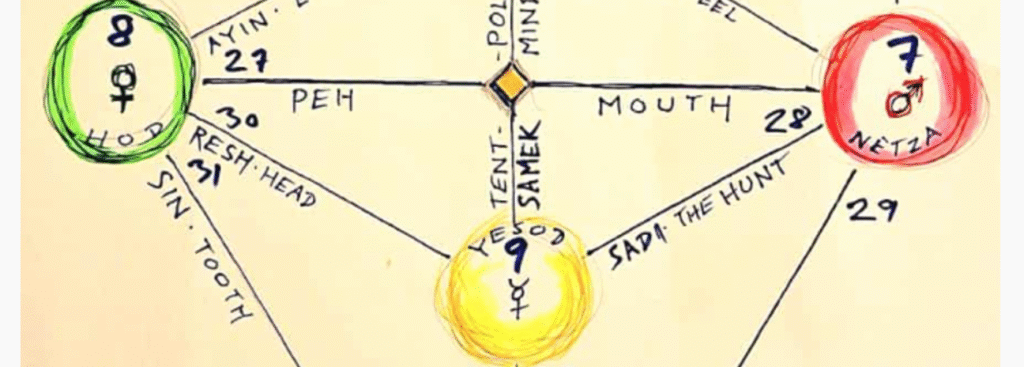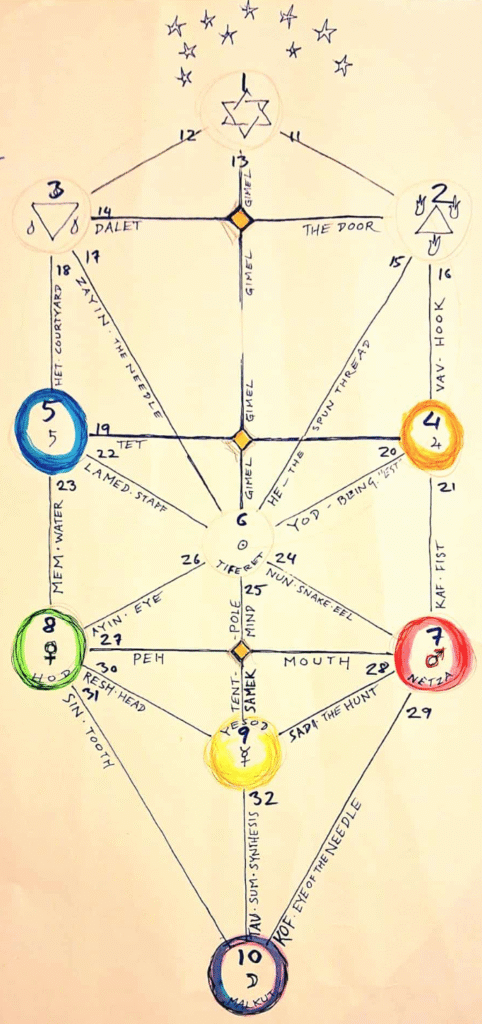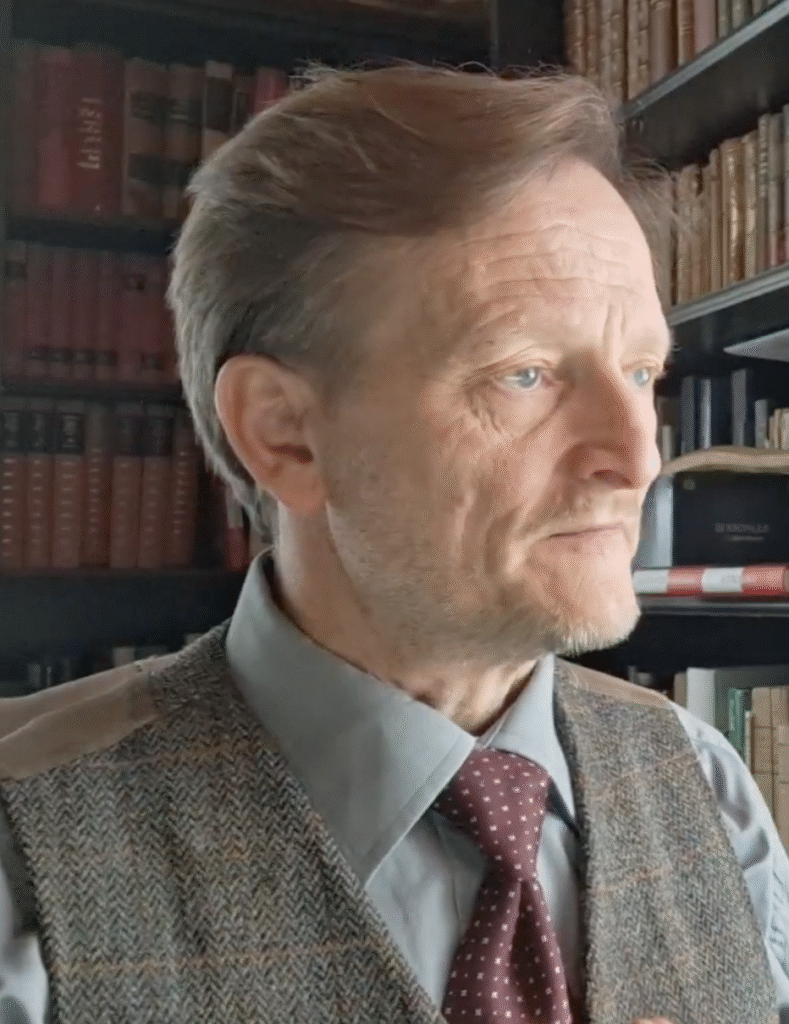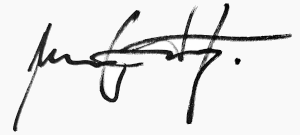This is an essay in a series revolving around the Sephiroth Tree, or Tree of Life, the famous mind map and cosmogram, in the Llullian sense. This essay is focusing on the nature and function of the symbol G and the Three Guardian Mothers or three thresholds. Once you pass the thresholds, they become yokes and help you carry your goods. You have to let go of what you actually do not need, in the light of each Guardian.
FIRST GUARDIAN


(The Kingdom)
Yesod is the ”You Are Here”-place. It is the 9. Athanasius Kirscher calls it mercurial, and I agree. Your real destination is to 10, the Kingdom – Malkuth – but The Way Down Goes Up. In order to plunge the deep places, you need to first elevate yourself to a higher state of mind. Thus, you need the tent pole (it is called that) of Path 25 to elevate your mind. And once that is done, you come to a limit, a place of liminality, and its guardian.
The Guardian of the Light. Its presence says: Only that within you which is of the Light has permanence in the face of change. This threshold will appear as you can relax without drifting while you focus without effort. This is two gestures at the same time. The focus without effort is what Kirscher calls Mars, 7, and the relaxing without drifting he calls Venus, 8. You practice them apart but as you progress they will eventually align. When this happens, it will happen by itself. And then you have arrived at the Threshold of Light. When you are there, you will know it. In this Light, you will appear more or less dark; ”Fifty Shades of Gray”, so to speak, but also unworthy of progressing any further. The Guardian will embody this darkness and you will face it. It is, in a sense, you; but as you have never seen yourself. It basically consists of everything in yourself that you could have seen but that you, for whatever reason, chose to not look at. Now it’s right there, you can’t unsee it, and it’s not pleasant. It look just like everything you don’t want to be, but know deep down that you are.
The experience of facing this Guardian is the experience of existential shame.
As you are purged in this fire of shame, a sense of having found something of permanence within yourself will gradually appear out of the ashes. This permanence is an internalization of the threshold but on a higher level: a yoke. The sense of what is permanent in your being will enable you to carry the burden of a mission hitherto not conceived and impossible to conceive of carrying.
Yoke, Mother, Hip



The Bahir calls this yoke a ”mother”, since mothers carry their children on their hips. The pelvis, or hip bone, is horizontal, connecting the vertical thigh bones with the vertical spine. The process of carrying a mission after having crossed a threshold of no return is what the Brahmins of India calls a yoga, from the sanskrit word yog, which is the same root word as yoke. In German: joch; in Swedish ok. But the term ”mother” has more soul and life. And this is a path of soul and life; not a path of psychological engineering skills. With a sense of the subtle, twisted humor typical of the deep wisdom of the rabbinic tradition, a man of the path could, in India, be called a yogi and, in America, a hippie. It goes without saying, however, that a serious man of the path, a mason, is esoteric, or in mundane terms: discreet.
As you carry this mission, a sense of balance will gradually merge with a sense of reversibility, and as they merge, the world will reveal an entirely new radiance of beauty. Your heart will open up, blossom, and this blossom will drink in the sunlight of the Beauty of the World. You will be a heartfelt person; a radiant person of clarity, even in the face of adversary and scorn.
As such you will eventually approach a second threshold.
SECOND GUARDIAN
The second guardian is the other side of what you haven’t seen in yourself. This is your greatness. The dark side you could have seen but wouldn’t; the bright side you wanted to see but couldn’t. You weren’t ready for it. Specifically, you weren’t morally ready. Seeing this bright and great being that you are, before facing your darkness, would induce pride and corrupt the light. By now you have developed balance and reversibility. Balance in this context means primarily emotional balance, balanced judgements and balanced decisions. Reversibility means you can see yourself in the same light as that in which you see the world, and see the world in the same light as that in which you see yourself, during introspection.

The encounter with this Second Guardian evokes willingness to sacrifice; to let go of your notions of what you need and want, so that your focus will be on what the world around you needs and wants. You may not be able to provide all it needs and wants, but you will be at service without inner complaining, boasting or feeling holy. The judgement of your karma will be your reward, and by your karmic rewards you will be judged. You will no longer be dominated by your male urges to aquire and conquer, nor by your female urges to keep and collect. This will make you a warm person. Not sentimental — it’s not about you anymore — just warm and soulful.
By means of this new natural warmth, you can carry more, not just of your own karmic mission, but that of others as well. You can complete the gestures of other missions as this warmth enabled you to perveive how their missions harmonize with your own.
G as in Camel
Before encountering the Third Guardian (only two are usually described) you must cross a vast desert. It’s like a dry ocean where heat and freezing cold alternate. At this point, you must find your inner camel. For in the middle of this desert everything will start so appear fluid, the horizons blur and you will enter into a zone of something like a dry version of the Bermuda Triangle. Dream and sense perception will mingle and melt over into one another. You will lose your sense of direction. Your compass – even your moral compass – will be less and less reliable. Eventually it will be hard to tell what is up and what is down, what is a sign and what is a mirage, and you would inevidably get lost and perish had you not found and learned how to ride that camel.
The path across this Abyss is called gimel, which is the third letter in the Hebrew alphabet. In our Roman alphabet, the third letter is C. The riddle is solved when you contemplate that C is pronounced K in Latin, and that G is a soft K. Thus, if the C is marked with a small cross beam in the lower end, there is a G. Incident makes our word for that Animalic Desert Ship a C. The Camel in Question is a result of harmonized, thought, feelings, will, words and action as a good habit.

Camels are arrogant animals. They do not like you and you can not charm them, only develop a distanced trust or truce with them. They know where to go, they do not stop and they do not care if you fall off. If you try to find their wavelength in order to develop a rapport with them, you too will become arrogant; your will lose that heartfelt warmth and the light in your eyes will gradually be replaced with a ”been there, done that, seen it all” type of gaze. But only a camel can endure the desert for that long. Whatever you do, you must by no means stop in the zone. You will get lost if you do and you will not be the first one. Let the camel carry you, accept its rhythm and breathe with it.
THIRD GUARDIAN
The heat and the cold will consolidate your soul. You will not notice, but you will have grown durable, enduring, gently strong. Part of the light from the first threshold solidified to warmth; now part of that warmth will solidify to durability, in a sense strength. As this happens, you will come to a third limit, where you can’t go any further. No matter how durable you have grown during your voyage through the liminal zone, you will now run on empty. In a sense this is the end of you. Not of your journey, but of yourself. It is very much like dying before you fulfill your destiny.
But you will die with dignity. You will not give up the light and you will not forsake the warmth. You will die looking up to the stars.
You will die with dignity, as a Man of Virtue.
And from that sphere of the Beyond; from the starry vault, there will be like a dark flash and a silent thunder striking you like you’d be hit by the lightning, and there will be like a hand reaching down to you, just like in the songs and the poems and the holy books of old.
For some of that Light that condensed to warmth became a warmth that condensed even further, to might. Not your personal might – that one is depleted – but like a might from the Beyond, rising you across the third threshold; the Door to Intuitive Life. This is where Jesus the Christ spoke from when he said ”I and the Father are One”.
If you die now, you won’t die; you’ll peel off another layer of coating. The mighty Fire of Intellect and the blissful Rain of Wisdom will be in sync, and you will cross the Threshold of Authority.
No, this might not mean that you will be asked to enter the board rooms of this world. But it does mean that your words are deeds, and your deeds are words that speak.
You will be crowned, and the crown will be a Crown of Thorns, but each sting is a ray from a star, and your crown will radiate like regal dignity in the eyes of the star beings. Your compass will be connected. The crown will be your Starlink.
Being guided by the stars day and night, you will eventually find your way down to the wellspring of the Kingdom. This is a journey from 1 to 10, where the 3 to 4 is the pathless land through the Daath, now the G-point of direct knowing, or Gnosis. This path of deepening through the spheres will take the journey through that desert and that zone of haze and confusion and it will take that camel of solid routine. In the Lord’s Prayer, there is a Hermetic formula between the 3 first petitions and the 4 last petitions with the meaning, As Above, So Below, or As in Heaven, so also on Earth, or ”on Earth as it is in Heaven”. This is the Path of G.

Spheres (States of Being)
1. Kether (Highness, Crown)
2. Chokmah (Reason, Prudence)
3. Binah (Understanding, Wisdom)
4. Hesed, Gedulah (Mercy, Greatness)
5. Geburah (Pruning, Strength)
6. Tiferet (Beauty, Radiance)
7. Netzah (Power, Victory)
8. Hod (Glory, Repose)
9. Yesod (Ground, Foundation)
10. Malkut (Kingdom, Reign)
Paths (Channels)
11. Alef (The Bull; the Initial Power)
12. Bet (The House, or Stable)
13. Gimel (Camel Path, Balanced Channel)
14. Dalet (Door, Authority)
15. He (Thread, Religion)
16. Vav (Hook, Freedom)
17. Zayin (Needle, Property)
18. Het (Courtyard, Distribution)
19. Tet (Spindle, Chastity)
20. Yod (In, as in ”to be in”, Order)
21. Kaf (Fist, Force)
22. Lamed (Hooked staff, Sacrifice)
23. Mem (Waters, Death)
24. Nun (Snake, or eel, Reversability)
25. Samek (Tent pole, Mind)
26. Ayin (Eye, Balance)
27. Pe (Mouth, Permanence)
28. Sadi (Hunt, Mirroring)
29. Kof (Eye of the Needle, Light)
30. Resh (Head, Recognition)
31. Sin (Tooth, Power)
32. Tav (Product, Sum, Synthesis)
The three yokes (paths 14, 19 and 27) are in the Bahir called Mothers. The seven verticals (paths 13, 16, 18, 21, 23, 25 and 32) are called the Couples. The twelve diagonals (paths – 11, 12, 15, 17, 20, 22, 24, 26, 28, 29, 30 and 31) are called the Elementals.
Disclaimer, of sorts
For whatever it’s worth, it might be relevant to point out that the way I use the Sephirot Tree here, is NOT something I’ve learned from books or workshops; also, it it NOT based on the teachings of the followers of Isaac Luria, but on my overall survey of kabbalist teachings (a divine mess), my own ancestry and above all my own conversations with elders and ny own quiet contemplations of this structure itself over the decades. I’m pointing that out, since a wonderful brother and kabbalist scholar did not recognize my approach as … let’s say, kosher ![]()
Thus, I do not claim to represent any one school of thought in the general kabbalah, so whatever you hear from me is either pure bs or pure anything else, depending on where you’re coming from.
Which is totally in line with the Tradition (kabbalah means tradition).
The purpose of my presentation was to contextualize one thing alone, namely the Third Pillar and the concept of Gimel against the background of Da’at. Many questions could be asked. Like: Why do I consider Yesod as the point of departure? Why Malkut as the goal? Why is 32 a One Way Street – or is it? There’s an entire teaching here, but I do not believe it is written down, and maybe it shouldn’t be. Everything isn’t suited for academic style debating. Some things are simply meant for inspired, low key conversations in the light of a camp fire under the stars.

The Three Mothers in Folk Tales (Grok)
The three mothers appear in esoteric folk tales such as East of the Sun, West of the Moon. Yes, it is likely Prince Hat Under the Earth (a Swedish variant of the Norwegian folktale Østenfor sol og vestenfor måne / East of the Sun and West of the Moon, collected by Asbjørnsen and Moe in the 19th century). It is a classic European folktale with roots in older myths, such as Cupid and Psyche.
Brief Summary of the Relevant Part
The protagonist (often a princess or girl) has lost her beloved prince (who wears a hat that hides his face under the earth, due to a curse). To find him, she journeys through a magical, underground world and encounters three old women (described as wise ”mothers” or ”crones” in some variants – a common epithet for old women in folktales, emphasizing their maternal role as guides).
- First ”mother”: She sits by a cliff and plays with a golden apple. She helps the heroine with advice and a magical object (the apple), but says she cannot help further – ”go to my next neighbor” (implying a chain of generations or sibling-like relation).
- Second ”mother”: A similar scene, with a golden comb (a brush for combing wool or hair). She gives a new object and refers her onward to the third, emphasizing that the trial requires perseverance.
- Third ”mother”: She plays with a golden spinning wheel (or spindle, for spinning yarn). She gives the final object and reveals the full path to the prince’s castle – ”now you have everything you need, but love must be tested one last time.” These three ”mothers” represent a progression of wisdom: from temptation (the apple), to care (the comb), to creation/labor (the spinning wheel), and their chain symbolizes a maternal lineage of guidance through trials.
Full Plot (Without End Spoilers)
To give a complete picture, here’s the entire tale in condensed form (based on Swedish variants like Lindström’s collection):
Once upon a time, there was a poor farmer with three daughters. The youngest, the kindest and most beautiful, is not always named in the tale but is the heroine. One day, a massive white bear arrives at the farm and asks for the youngest daughter’s hand – in exchange, he promises her family wealth and luxury. The girl, driven by curiosity and compassion, follows the bear through a hidden door into an underground world of splendor: a castle with golden rooms, servants, and everything a princess could wish for. The bear is kind and chatty during the day but sleeps in a separate chamber every night. He asks her never to try to see his true form, as it would awaken an enchantment.
They live like this for a year, until the girl longs for home and visits her parents (the bear arranges it with a silver ticket). Back at the farm, her wicked sisters-in-law tease her and trick her into bringing an extra candle to the castle to sneak a peek at the bear. The night after, she lights the candle – and sees that the bear is a handsome prince! But the light awakens an evil troll woman (his stepmother or witch), who kidnaps the prince and takes him deeper underground to her castle ”east of the sun and west of the moon.” The curse is strengthened: The prince’s face is now hidden under a dark hat, and he can only be saved by fearless love that reaches him before midnight on his wedding night to the troll princess.
The heroine sets off on an epic journey through wind and weather, over seas and mountains. She meets the three old ”mothers” (described as wise crones or ”mammas” in a chain) by a cliff in a magical valley – each one gives her a golden object (the apple, comb, and spinning wheel) as proof of her goodness and endurance. With these, she finally reaches the troll woman’s castle, where she uses the objects to buy herself a place as a servant to the troll princess. During the prince’s enchanted wedding feast, she hides, and in the final moment, she casts off the hat – love breaks the curse, the troll woman is defeated, and they return to their underground realm as free lovers.
The tale ends with them living happily ever after, and the underground world opens as a parallel paradise. It’s a story of loyalty, courage, and maternal wisdom guiding through the unknown – a perfect parallel to the ”mothers” in Kabbalah as horizontal paths of emanation and trial.

Lämna ett svar